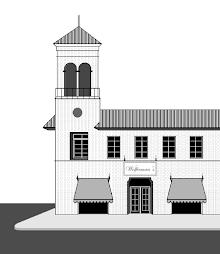Fifty shopping malls have been built in Los Angeles County since 1951. Keep in mind, this does not take into account malls developed in the surrounding counties of Orange, Ventura, Riverside and San Bernardino.
We cover eleven failed shopping centers in our LOST MALLS OF LOS ANGELES COUNTY section. These are listed as follows, using the original names of each complex:
*WHITTIER QUAD [1953-1987]
*POMONA VALLEY CENTER [1955-1995]
*LOS ALTOS CENTER [1955-1996]
*WHITTIER DOWNS MALL [1955-1988]
*WHITTWOOD CENTER [1956-2004]
*EASTLAND CENTER [1957-1997]
*SEARS EL MONTE CENTER [1959-1986]
*LA MIRADA CENTER [1959-1988]
*FALLBROOK SQUARE [1963-2001]
Modern rail transit arrived in Los Angles with the Metro Blue Line. The initial 22.0 route mile, light rail operation was inaugurated in July 1990. The Metro Red Line, a heavy rail / subway operation, was dedicated -with 4.4 route miles- in January 1993.
*WHITTIER QUAD [1953-1987]
*POMONA VALLEY CENTER [1955-1995]
*LOS ALTOS CENTER [1955-1996]
*WHITTIER DOWNS MALL [1955-1988]
*WHITTWOOD CENTER [1956-2004]
*EASTLAND CENTER [1957-1997]
*SEARS EL MONTE CENTER [1959-1986]
*LA MIRADA CENTER [1959-1988]
*FALLBROOK SQUARE [1963-2001]
*OLD TOWNE MALL [1972-1990]
*HAWTHORNE PLAZA [1977-1999]
Two additional LOST MALLS were built in the 1980s; COURTYARD MALL [1981] (now PROMENADE ON THE PENINSULA) {in Rolling Hills Estates} and SANTE FE SPRINGS MALL [1985] (now GATEWAY PLAZA) {in Santa Fe Springs}.
The region's first motor expressway, the Arroyo Seco Parkway, opened to traffic between December 1938 and January 1941. This roadway connected downtown Los Angeles with suburban Pasadena and was the first operational segment of the region's present-day -527-mile- expressway grid. The City of the Angels was presented with its first "freeway friendly" mall in 1957. EASTLAND CENTER was built adjacent to "The 10" (Interstate 10-San Bernardino Freeway).
*HAWTHORNE PLAZA [1977-1999]
Two additional LOST MALLS were built in the 1980s; COURTYARD MALL [1981] (now PROMENADE ON THE PENINSULA) {in Rolling Hills Estates} and SANTE FE SPRINGS MALL [1985] (now GATEWAY PLAZA) {in Santa Fe Springs}.
Major arterials of the Los Angeles expressway network form the basis of our LOST MALLS map. On this diagram, eleven failed shopping centers are indicated
with gray squares. Other major retail facilities are
shown with black squares.
Click on image for a larger viewThe region's first motor expressway, the Arroyo Seco Parkway, opened to traffic between December 1938 and January 1941. This roadway connected downtown Los Angeles with suburban Pasadena and was the first operational segment of the region's present-day -527-mile- expressway grid. The City of the Angels was presented with its first "freeway friendly" mall in 1957. EASTLAND CENTER was built adjacent to "The 10" (Interstate 10-San Bernardino Freeway).
Modern rail transit arrived in Los Angles with the Metro Blue Line. The initial 22.0 route mile, light rail operation was inaugurated in July 1990. The Metro Red Line, a heavy rail / subway operation, was dedicated -with 4.4 route miles- in January 1993.
The Metro system now operates with six color-coded lines; B and D (heavy rail) and A, C, E and K (light rail). Expansions were opened in 1995, 1996, 2000, 2003, 2012, 2016, 2020 and 2022. As of 2024, there were 107.4 route miles and 100 station stops on the transit train grid.
And away we go!




